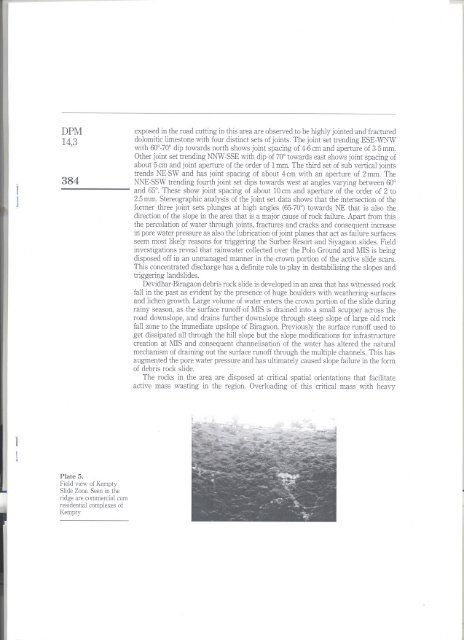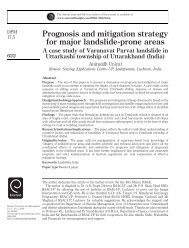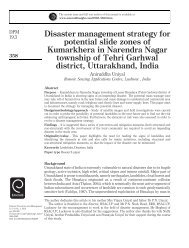Disaster management strategy for avoiding landslide induced losses to the villages in the vicinity of the Himalayan township of Mussoorie in Uttaranchal (India)
Disaster management strategy for avoiding landslide induced losses to the villages in the vicinity of the Himalayan township of Mussoorie in Uttaranchal (India)
Disaster management strategy for avoiding landslide induced losses to the villages in the vicinity of the Himalayan township of Mussoorie in Uttaranchal (India)
Create successful ePaper yourself
Turn your PDF publications into a flip-book with our unique Google optimized e-Paper software.
I J<br />
I<br />
I I<br />
~<br />
DPM<br />
14,3<br />
384<br />
Plate 5.<br />
Field view <strong>of</strong> Kempty<br />
Slide Zone. Seen <strong>in</strong> <strong>the</strong><br />
ridge are commercial cum<br />
residential complexes <strong>of</strong><br />
Kempty<br />
exposed <strong>in</strong> <strong>the</strong> road cutt<strong>in</strong>g <strong>in</strong> this area are observed <strong>to</strong> be highly jo<strong>in</strong>ted and fractured<br />
dolomitic limes<strong>to</strong>ne with four dist<strong>in</strong>ct sets <strong>of</strong> jo<strong>in</strong>ts. The jo<strong>in</strong>t set trend<strong>in</strong>g ESE-WNW<br />
with 60°-70°dip <strong>to</strong>wards north shows jo<strong>in</strong>t spac<strong>in</strong>g <strong>of</strong> 4-6cm and aperture <strong>of</strong> 3-5mm.<br />
O<strong>the</strong>r jo<strong>in</strong>t set trend<strong>in</strong>g NNW-SSEwith dip <strong>of</strong> 70°<strong>to</strong>wards east shows jo<strong>in</strong>t spac<strong>in</strong>g <strong>of</strong><br />
about 5cm and jo<strong>in</strong>t aperture <strong>of</strong> <strong>the</strong> order <strong>of</strong> 1mm. The third set <strong>of</strong> sub vertical jo<strong>in</strong>ts<br />
trends NE-SW and has jo<strong>in</strong>t spac<strong>in</strong>g <strong>of</strong> about 4 em with an aperture <strong>of</strong> 2mm. The<br />
NNE-SSWtrend<strong>in</strong>g fourth jo<strong>in</strong>t set dips <strong>to</strong>wards west at angles vary<strong>in</strong>g between 60°<br />
and 65°. These show jo<strong>in</strong>t spac<strong>in</strong>g <strong>of</strong> about 10em and aperture <strong>of</strong> <strong>the</strong> order <strong>of</strong> 2 <strong>to</strong><br />
2.5mm. Stereographic analysis <strong>of</strong> <strong>the</strong> jo<strong>in</strong>t set data shows that <strong>the</strong> <strong>in</strong>tersection <strong>of</strong> <strong>the</strong><br />
<strong>for</strong>mer three jo<strong>in</strong>t sets plunges at high angles (65-70°)<strong>to</strong>wards NE that is also <strong>the</strong><br />
direction <strong>of</strong> <strong>the</strong> slope <strong>in</strong> <strong>the</strong> area that is a major cause <strong>of</strong> rock failure. Apart from this<br />
<strong>the</strong> percolation <strong>of</strong> water through jo<strong>in</strong>ts, fractures and cracks and consequent <strong>in</strong>crease<br />
<strong>in</strong> pore water pressure as also <strong>the</strong> lubrication <strong>of</strong> jo<strong>in</strong>t planes that act as failure surfaces<br />
seem most likely reasons <strong>for</strong> tJ.;gger<strong>in</strong>g<strong>the</strong> Surbee Resort and Siyagaon slides. Field<br />
<strong>in</strong>vestigations reveal that ra<strong>in</strong>water collected over <strong>the</strong> Polo Ground and MIS is be<strong>in</strong>g<br />
disposed <strong>of</strong>f <strong>in</strong> an unmanaged manner <strong>in</strong> <strong>the</strong> crown portion <strong>of</strong> <strong>the</strong> active slide scars.<br />
This concentrated discharge has a def<strong>in</strong>ite role <strong>to</strong> play <strong>in</strong> destabilis<strong>in</strong>g <strong>the</strong> slopes and<br />
n;gger<strong>in</strong>g <strong>landslide</strong>s.<br />
Devidhar-Biragaon debris rock slide is developed <strong>in</strong> an area that has witnessed rock<br />
fall <strong>in</strong> <strong>the</strong> past as evident by <strong>the</strong> presence <strong>of</strong> huge boulders with wea<strong>the</strong>r<strong>in</strong>g surfaces<br />
and lichen growth. Large volume <strong>of</strong> water enters <strong>the</strong> crown portion <strong>of</strong> <strong>the</strong> slide dur<strong>in</strong>g<br />
ra<strong>in</strong>y season, as <strong>the</strong> surface run<strong>of</strong>f <strong>of</strong> MIS is dra<strong>in</strong>ed <strong>in</strong><strong>to</strong> a small scupper across <strong>the</strong><br />
road downslope, and dra<strong>in</strong>s fur<strong>the</strong>r downslope through steep slope <strong>of</strong> large old rock<br />
fall zone <strong>to</strong> <strong>the</strong> immediate upslope <strong>of</strong> Biragaon. Previously <strong>the</strong> surface run<strong>of</strong>f used <strong>to</strong><br />
get dissipated all through <strong>the</strong> hill slope but <strong>the</strong> slope modifications <strong>for</strong> <strong>in</strong>frastructure<br />
creation at MIS and consequent channelisation <strong>of</strong> <strong>the</strong> water has altered <strong>the</strong> natural<br />
mechanism <strong>of</strong> dra<strong>in</strong><strong>in</strong>g out <strong>the</strong> surface run<strong>of</strong>f through <strong>the</strong> multiple channels. This has<br />
augmented <strong>the</strong> pore water pressure and has ultimately caused slope failure <strong>in</strong> <strong>the</strong> <strong>for</strong>m<br />
<strong>of</strong> debris rock slide.<br />
The rocks <strong>in</strong> <strong>the</strong> area are disposed at critical spatial orientations that facilitate<br />
active mass wast<strong>in</strong>g <strong>in</strong> <strong>the</strong> region. Overload<strong>in</strong>g <strong>of</strong> this critical mass with heavy





